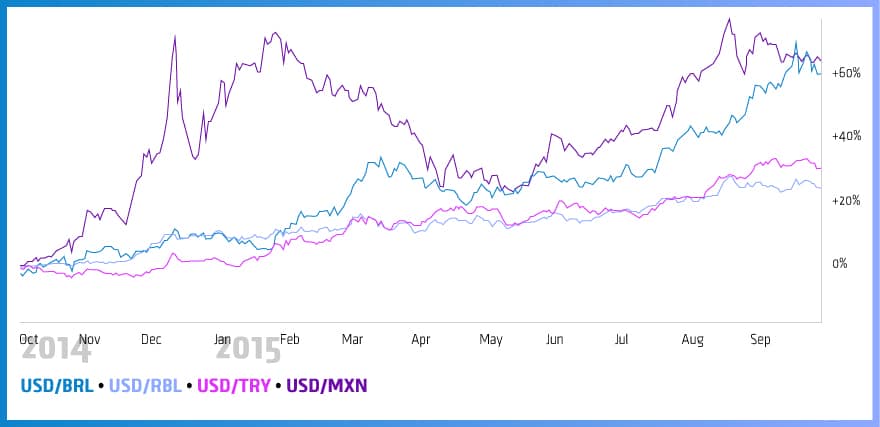This article is written by Otto Fassheber Jorand, who is an Independent Analyst & Portfolio Manager
According to the Hawley Economic Theory, profit is a reward for risk taken in business. The higher the risk in business, the greater the potential financial reward is for the business owner.
Trading emerging markets (EM) currencies nowadays could be the riskiest trade out there, and following the Hawley Theory, a risk which may be rewarded with the biggest potential profit you ever seen. But only the brave can get involved now on the market.
In the last 12 months every EM currency has fallen against the US dollar. Some currencies like the Brazilian real, the ruble and the Colombian peso have fallen more than 30 percent over the past year for some of the worst global selloffs.
But EM problems have been building for years, fed by credit bubbles, plunging commodity prices, unstable domestic politics, China’s economic slowdown, and current account deficits. These are just some of the factors that have sent EM currencies into freefall.

Otto Fassheber Jorand
The Brazilian real began the year with a change of 2.5 reals per dollar, and at the end of September the Brazilian currency touched its lowest rate in history, trading for 4.25 R$ per dollar. See the chart below.
The Institute for International Finance (IIF) estimates that EM will lose about 540 billion dollars on capital exit this year; it’s the biggest 'hot money' withdrawal since the 2008 Lehman Brothers default. Borrowing costs have climbed above the levels seen during 2013’s 'taper tantrum' as investors run away from risk punishing hard EM government bonds.
So why would someone be so brave, or so dumb, to fight that war?
The answer is the simplest: because it is cheap!
Let’s get back to basic instincts. The main objective of any trader in the world is making profit by buying low and selling high. That EM currencies are extremely undervalued is something very clear, but expecting a rebound in the near future is the hard part of the deal.
Actually it is not about trying to find the bottom for EM currencies, it’s about feeling comfortable with the risks taken and the potential rewards involved. It’s a matter of faith and appetite for risk.
So where are investors getting lost?
After the 1997 Asian crisis, EM policymakers built up foreign Exchange reserves large enough to absorb and deter speculative attacks on their currencies. Following the IIF estimates, EM central banks have foreign reserves enough to handle a 20-year storm before running out of cash.
Commodity prices are closer to their production costs- after a long way down, the commodities macro cycles could be turning, as suppliers are closing production facilities. And, a small rebound on the demand side could take time to be covered by producers eventually pushing prices higher.
Carry trading – the high interest rates offered for EM currencies deposits is already a hedge position against currency devaluation, and the swap rates paid on holding EM currencies against the dollar could cover a great part of the risk. Getting 1 USD borrowed at 0.25% annual interest rate in the US whereas the investor could lend the same money in Brazil for about 15% annual interest rate, which means that if the currency rate didn’t change during that period, the investor would made about 14% profit in a year.
The FED interest rate decision and China growth, the Big Data …
The China economic slowdown has affected all EM currencies, when commodity prices were put under strong bullish pressure, but at the same time, raw material exporters took advantage of the EM currencies devaluation. Colombian coffee exporters lost about 12% in the last 12 months, due to the coffee price devaluation based on the dollar, but if we take into consideration that the Colombian peso has devalued over 40% in the same period against the dollar, exporters still have domestic currency based benefits.
Going Forward
Expectations are that the Federal Reserve will soon embark on the first interest rate increase since 2006, threatening to lure capital away from developing nations. This combined with a soft landing in China poses significant risks to EM currencies, but as I have argued, this is all about confidence.
Investors may see a FED rate rise decision as something positive, or at least a better forecast for the Chinese economy. One of the main reasons why the Federal Reserve kept rates unchanged in its last meeting in September was worry over China and EM markets (please read last article), so a rate rise could be read by investors as a bright light over the world economy growth forecast.
There are too many cards on the table, but only the brave are willing to make a move right now. They will pay the ultimate price or get the ultimate prize… GERONIMO!!!!























